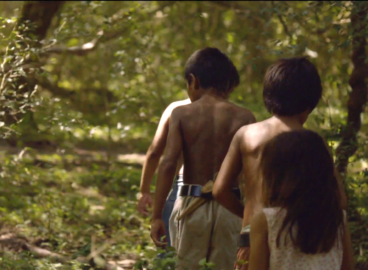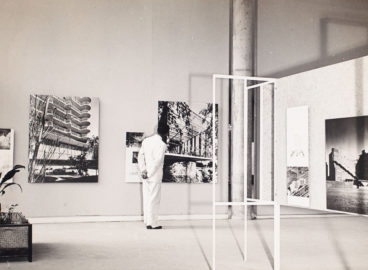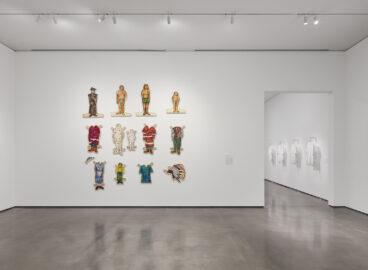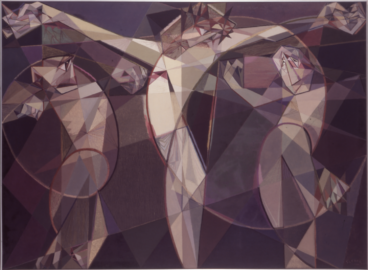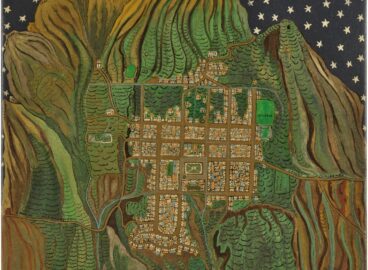In this interview, recorded a few months before Davidovich’s passing, curator Ana Janevski talks with the Argentine-American artist about his career, his early days in New York City and Cleveland, and his work Tape Wall Project (1970/1988), recently acquired by MoMA.
This is the second of two parts. Read the first part of the interview here.

Ana Janevski: And so you decided to start using tape as a way to go beyond painting?
Jaime Davidovich: Yeah.
AJ: But it seems that very early on you also became interested in videotape. Because in the drawing of the Tape Wall Project that’s part of MoMA’s collection, it looks like you’re already thinking about the TV screen that should be on the wall.
JD: Yes.
AJ: Very early on, you had a clear idea of how would you like to use technology and, in particular, television.
JD: Oh, sure. I wanted to embed the television, to make the screen even with the wall. I didn’t want it to be a three-dimensional, bulky object—like TVs were at the time—I wanted it to be flat.
AJ: Hmmm . . . like a flat-screen.
JD: Like a flat-screen, yes. And then I started doing work in New York, in the places
that had started to show video. And I was very active.
AJ: Your first video work was Road, from 1972.
JD: Yes, yes. My first “tape period” was 1965 to 1975. Ten years. Ten years of tape. Actually, I have the first collage with adhesive tape in my possession and it’s dated 1965.
AJ: And when did you discover video? JD: Video . . . I discovered video in 1970.
AJ: 1970, and then you immediately made the connection between videotape and adhesive tape.
JD: Sure. And also, it’s the word. It’s videotape. The videotape in those days literally was tape. People today, especially young people, don’t know that a videotape is a roll of tape. I started a whole series about art as tape and tape as art—a series that combined the two. It was a pretty natural connection.

AJ: Another thing that is interesting in both your tape interventions and your video works is the way you use the architectural space . . .
JD: Well, that’s a very important thing, very important. I was not interested in covering a wall in an exhibition space with tape. I was interested in using spaces that were not considered appropriate frameworks for an artwork—for instance, in doing a tape project on a sidewalk, which is a public space, or on a billboard . . . I also wanted to have pieces in museums but not in the traditional exhibition spaces, but rather in the elevator or staircase. In the case of the Whitney Biennial, when Marcia Tucker asked me what I wanted to do, I said, “I want to do the largest piece ever shown at the Whitney Museum.” And so I ran tape from the top floor all the way to the basement.
Then, I was invited to do a show at the Bykert Gallery. There, I didn’t use the traditional exhibition space but rather a platform they had, where all the lights were inserted, and I covered it with tape. Like what Brian O’Doherty was proposing at that time, I was arguing that art should not be shown in the beautiful, pristine white cube. I wanted to say that art should go out of the museum and into the general life, into the general public, to show the contrast between the work and the space. And you know, I think that Minimal art should be shown at Macy’s and Bob Rauschenberg’s Erased de Kooning Drawing should be shown at Walmart. Instead of taking the Brillo
box from the supermarket and putting it into the gallery, taking what is in the gallery and putting it in the supermarket.
AJ: And is this what you tried to do with television?

JD: Yes. In 1975 I came in contact with this new technology that made a huge revolution in the way we see television, and it was cable television. And I was very interested in that—in the possibilities of cable television, of doing things at home and putting them in a context that is not supported by an institution. There’s no distinction. Cable television was presented as a subversive alternative to what you were seeing on commercial television. And that’s when I started working with Cable SoHo and then the Artists’ Television Network. This started in 1975 and ran until 1985—for another ten years.
AJ: And what were you doing at Cable SoHo?
JD: Well, the idea of Cable SoHo was very ambitious, and many decades ahead of its time. Cable SoHo’s concept was to create an independent television channel based in SoHo. We wanted to incorporate the activities that were happening in SoHo, and to cablecast them to the rest of the city or to the rest of the country. Because at that time, in SoHo, we had all the alternative spaces in New York—and in the United States. We had The Kitchen, Anthology Film Archives, Artists Space, Franklin Furnace . . . And the idea behind Cable SoHo was to dedicate one day to Artists Space, another day to Anthology Film Archives . . . Every night, we would go to The Kitchen and videotape the performance and cablecast it live . . . We had a van with all the necessary equipment, the transmission and reception equipment, and we’d take it to these different locations and cablecast from there.
AJ: Were there other artists working with you? JD: Yes. Doug Davis, Bob Stearns . . .
AJ: And how was it transmitted?
JD: From the truck.
AJ: From the truck?
JD: From the truck, because cable television in New York City came from the New York City Hall. And the main cable was underneath Broadway. So for SoHo, it was very easy to get a hookup to that main cable and have a line of direct transmission to the cable television station that, at that time, was called Manhattan Cable Television. At that time, there was no cable in SoHo. The only cable in New York was between 14th and 55th Streets. So it was very limited service.
AJ: What was the difference between the Cable SoHo and the Artists’ Television Network?
JD: Cable SoHo was creating a discrete system. We were not able to raise funds, because the idea was too farfetched for the funding organizations—and the cable company did not see the potential. Actually, there were dozens of channels with nothing to broadcast. They would broadcast bulletin boards, because they had no product. Nobody was producing anything. Financially, we could not do what we wanted. So we had to either forget about the whole project or make a deal with the cable company to get a channel. Because, again, they had nothing to show.
We would take the channel and broadcast programs that we had already produced. There were a lot of video artists at the time. We would organize the shows into series, like commercial television, that ran for thirteen weeks. Thirteen weeks is the magic number. We would organize a thirteen-week series, using the cable-station channel, and then we would take these shows to people’s homes and they could watch them from there. However, at that point, a lot of artists disagreed with the idea, because they thought that they were not gaining anything specific from it. Others said, “This is an opportunity of a lifetime, but the artists have to get something out of it. A fee, something.” So I went to the National Endowment for the Arts and had a long talk with Brian O’Doherty, who was the director of visual arts there, and I explained to him the situation. He was 100 percent behind the idea. And he said, “I’ll give you the initial funding to start operating.” And with that funding, Cable SoHo changed its name to Artists’ Television Network—a network of very experimental work, with new formats, new standards, and work that had never before been imagined on television.
The series was called SoHo Television Presents. It was 1977 and we showed work by Nam June Paik, Laurie Anderson, Boghosian, Juan Downey, John Cage . . . many, many artists. And then in 1978, I had another idea: a live show.


AJ: And this was your own show?
JD: That [The Live! Show] was my own show. Live from the TV station in Manhattan. It was later distributed to different cities and countries. It ran until the middle of 1984 or 1985. 1985 was a year of major change in the art world. Before, since 1975, was like the golden years of SoHo. Everything was happening there, outside museums and mainstream galleries. There was a whole movement focused on taking elements from popular culture and putting them into the art world, and vice-versa. At that time, we called the artists working in this way crossover artists. Laurie Anderson was a typical crossover artist. Cindy Sherman was a typical crossover artist.
AJ: How was your work read in Latin America? Was it discussed at all? JD: No, no, not at all.
AJ: The first time you had the opportunity to show the Tape Wall Project was in the Bronx Museum, right?
JD: Which show?
AJ: The “Latin American Spirit: Art and Artists in the United States, 1920–1970.”
JD: Yes. And that was an important show, in part because it was focused on Latin America, but more because it was a creative force in the international art movement.
AJ: But you had been doing tape installations since the 1970s . . .
JD: Yes, in 1971, I did very similar things—video installations, tape installations. I did one piece covering the whole coastline of Latin America with tape. A lot of Conceptual pieces, at the CAYC [Centro de Arte y Comunicación (Center for Art and Communication)] in Buenos Aires.
It was not the first time. But within the context of Latin American art and anthological shows, I was never involved. I’m still not. But that’s a Latin American issue; they have their own set of guidelines. But I think that’s changing, because people are traveling, people are studying in different countries, and they’re realizing what’s going on in other places. One thing that is very good about the Internet is that you cannot lie. You have all the materials right there. You have the documentation right there.
AJ: Did you ever exhibit in other Latin American countries?
JD: I was in the São Paulo Biennial. I think it was in ’85 or ’83. But not as a representative of Latin America. No, no . . . rather as a representative of the new artists using new technologies. But as part of Latin America? No. No, I never showed in any other Latin American city. No. No. So my career basically . . .
AJ: Is here.
JD: . . . is here. . . Those things, yes, those things happened. All right. Anyway, we
should finish now, I have to be someplace else . . .
This is the second of two parts. Read the first part of the interview here.
